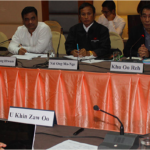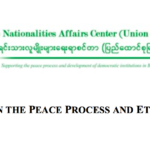KNU (Karen National Union) Vice-President Naw Zipporah Sein | January 14, 2016
1) LAIZA SUMMIT AND FORMATION OF NCCT
The efforts of the Ethnic Armed Organizations (EAOs) to negotiate a Nationwide Ceasefire Agreement (NCA) with the Burmese/Myanmar government began in November 2013 at the Ethic Armed Organizations Conference in Laiza, Kachin State, where the 16 Ethnic Armed Organizations (EAOs) established their Nationwide Ceasefire Coordination Team (NCCT).
At this first EAO Conference in Laiza, the basic principles for drafting a Nationwide Ceasefire Agreement (NCA) were also laid down. The NCCT then met with the Burmese/Myanmar government negotiation team, the Union Peace-making Work Committee (UPWC), and agreed to work on a single draft for the Nationwide Ceasefire Agreement, instead of each side working on its own version and negotiating on the basis of the different versions.
The official meetings between the NCCT and UPWC reached the 7th round of negotiation in March 2015, when both parties agreed to a final draft, the Single Text NCA, and sought approval for it from the highest authorities on each side, that is, the NCCT from the EAOs Summit Meeting and the UPWC from the government’s Union Peace Central Committee (UPCC). If approved, all parties would then officially sign the agreement in front of government officials and Members of the Parliament.
However, when the draft Single Text NCA was reviewed at the subsequent EAOs Summit Meeting in Law Khee Lar, Karen State, the EAOs decided that there were 15 points that needed further discussion and negotiation with the UPWC. The government initially refused to agree to any further negotiation on the draft Single Text NCA, stating that it had already been signed by the NCCT and UPWC, in front of the President. The government side suggested instead that the 15 points proposed by the EAOs Summit Meeting be put on record as “meeting decisions.” In response, the EAOs Summit Meeting formed a high level delegation known as the “Senior Delegation for Nationwide Ceasefire Negotiation” or “SD” to continue further negotiations with the government on the issue. After the 8th and 9th rounds of negotiations, both sides agreed to include most of the points recommended by the EAOs Summit Meeting in the NCA, under a category called “meeting decisions.”
At this point, the government refused to allow three of the 16 EAOs, represented by the NCCT and the SD, to sign the NCA. These three are the Palaung State Liberation Front (PSLF), the Arakan Army (AA), and the Myanmar National Democratic Alliance Army (MNDAA). There was also a second group of three organizations that the government also refused to allow on grounds that they did not have a significant number of troops. They are the Lahu Democratic Union (LDU), the Wa National Organization (WNO) and the Arakan National Congress (ANC). At the time, the three EAOs in the first group were facing government’s massive military offensives.
It is clearly stated in the last chapter of NCA that the NCA shall be signed by representatives from the government and representatives from the EAOs, as well as the international representatives and domestic personages, as witnesses. Nonetheless, the government continued to refuse the signing of the NCA by the 6 groups mentioned above. Out of the 7 countries proposed, the government also refused three international would-be witnesses, representing the US, UK and Norway to sign the NCA.
On the 15th of October 2015, 8 EAOs repudiated the EAOs Summit Meeting decisions and agreed to sign the NCA with the government. The other 7 EAOs refused to sign, and a total of 6 were not allowed to sign.
The signing of what the Burmese/Myanmar government billed as ‘Nationwide Ceasefire Agreement’ or NCA is neither nationwide nor results in a meaningful ceasefire agreement. However, for propaganda purposes Burmese/Myanmar officials and international peace supporters joined in the grandly organized signing ceremony in Naypyidaw (political capital of Burma), just before the November elections. I think the international community needs to understand as to why the nationwide ceasefire negotiations have not succeeded. I offer the following (4) reasons for the failure of the ceasefire negotiations, after nearly 2 years of hard work by all concerned.
a) The government refused to allow all the Ethnic Armed Organizations, which wanted to end armed conflicts in their regions through negotiations and by signing the NCA.
b) The government reverted to its old tactics of approaching and inviting individual EAOs, for division and isolation, while most EAOs were members of the alliance, the United Nationalities Federal Council (UNFC).
c) Even during the well-publicized ceasefire negotiations, the Tatmadaw (Burmese/Myanmar government Army) continued to launch military offensives against the EAOs in Northern Burma, particularly in the Kachin and Shan States. As if they were waging a war against foreign enemies, the Burmese/Myanmar government forces’ military offensives included air strikes and tanks against the EAOs, resulting in the deepening of the EOAs’ decades-old mistrust of the government; and finally,
d) The government has consistently failed to keep its end of the bargain reached in connection with the state level agreements with the EAOs. Specifically, the government side fails to implement “military area demarcation issues”. To give an example, in the interest of establishing durable ceasefire, the Karen National Union proposed a set of Codes of Conduct for troops on both sides, which included the relocation of Burmese/Myanmar military camps and outposts in the KNU areas, especially the ones close to Karen villages, farmlands, places of religious worship such as churches, monasteries and so on. In fact, the KNU only asked for the relocation of 150 out of the more than 300 Tatmadaw camps and outposts in the KNU region. Instead of heeding the KNU’s proposal and honoring the its promises, the government built even more camps and outposts – 13 camps and outposts in a single year of 2014.
2) TO MAKE CEASEFIRE TRULY NATIONWIDE & ALL-INCLUSIVE WITH NEW NLD GOVERNMENT
The current military dominated government is trying to move the peace process forward too quickly, so as to follow the timeframe laid down in the NCA text. According to the text, after signing the NCA, some steps have to be implemented, such as establishing a Joint Monitoring Committee, a Union Peace Dialogue Joint Committee, and to complete a Ceasefire Code of Conduct, all within 30 days. A political framework has to be completed within 60 days and a political dialogue should be started within 90 days after signing of the NCA.
However, as the NLD won a landslide victory in the November national elections, and the current government lost most of its seats, it has to hand over power smoothly to the new government within a few months. There is not enough time for the current government to continue and complete the process properly. Even if the current government pushes this process forward in a hurry, it will not go well and it will not bring positive results. There are two important things the current but out-going government should consider: one is that the new government will take over the process, and the second is the question of ‘how to include the remaining Ethnic Armed Organizations’.
It is very important to find a way to include those EAOs who did not, or could not, sign the NCA. This should be done before the political dialogue begins.
The representatives of the current government and the 8 EAOs, which had signed the NCA reached agreement to invite the non-signed groups to attend the political dialogue, with rights to take part in discussions but not in decision-making. If the current government still pushes on with the process and starts a political dialogue without the new government and without the remaining Ethnic Armed Organizations that have not yet signed the NCA, then the process will not bring significant or positive results. Instead, the situation will become even more complicated. The EAOs that did not sign the NCA, in fact are ready to coordinate with the new government to solve political problems.
3) ROLE OF THE INTERNATIONAL COMMUNITY, ESPECIALLY THE INTERNATIONAL SUPPORTERS OF PEACE AND RECONCILIATION PROCESS IN BURMA
First, I would like to thank the international community for supporting the Peace Process in Burma and particularly the Norwegian government that has supported the peace process in different areas of our country.
But there are a number of weaknesses the members of the International community may not realize, and which have had negative effects on the Peace Process. International representatives came with their own programs, plans and interests, and they pushed these ideas onto the local people and the EAOs.
They did not take time to watch, listen and understand the real situation of the peace process, nor the real needs of the EAOs and local communities. As soon as the EAOs signed preliminary ceasefires, representatives of the International community met with local and central leaders and discussed plans to start humanitarian development, economic development and demining processes. The EAOs were not ready to face a huge influx of the international community and its plans, straight after signing the preliminary ceasefires. This caused a lot of tension. Instead of having time to focus on the demands of the ceasefire process and political issues, local EAO leaders had to deal with a large number of new international actors in their areas, wanting to establish projects quickly. Misunderstandings were often created as a result, between local authorities of the EAOs and their own central level leadership. The international groups did not provide support or allow time for making the preliminary ceasefire into a durable ceasefire, but instead started the planning of humanitarian and economic development at local levels. They did not come to us to ask what we needed, or what our own plans were. They just told us what they wanted to do in their projects.
This made us very uncomfortable and it was particularly difficult for those leaders who are not used to dealing with international organizations. Our leaders are often not confident to say no to a guest. In our culture it is impolite. Additionally, leaders have been reluctant to reject the offers or ideas of International groups, because we have been made to feel that if we do not accept the idea, there will be no support at all. It has made leaders afraid to reject or even to make comments. In the KNU areas alone, since 2012, almost every day, we have had to meet with different international NGOs, or government agencies, which came with their ideas and plans to support us. But, sometimes, we feel under pressure and we have often been told this is “our best chance,” or “the only chance, perhaps”.
To be frank, some international donors and governments have been openly urging the EAOs to sign the NCA during the current administration. Often, they give us the same reasons that the Burmese government gives us: that the EAOs do not have a lot of time to wait but must go ahead and agree to whatever the government is willing to agree to. At times, we feel that the process is one-sidedly owned and dictated by the government. We feel we are under huge pressure by the government, backed by a powerful military force and the international community.
In fact, the signing of the NCA should not be dictated by the government or the government’s premature timeframe. It should be based on the contents of the NCA itself and whether or not signing it will actually take us to an inclusive political dialogue and eventually a genuine peace for the whole of the country, Burma.
Signing the NCA should not be just to receive international aid or international investment in the country. Our goal for signing the NCA is beyond these short term gains. While we know that the government’s focus is more on receiving international aid and getting more foreign investment, the EAOs want to make sure that the NCA will eventually lead them to a long term sustainable peace in the country. Before we reach agreement on political solutions, it is important that the EAOs are able to maintain their current administrations and territory. The EAOs are willing in the future to integrate military and administrative apparatus into a federal union army or government as a result of political dialogue and peace agreement. If the international community really wants to see peace and meaningful change in Burma, it should support the EAOs and their aim to solve political problems through political means. Support only for meetings between the EAOs and the Government is not enough. There is a need to support wider change of the current system and the Constitution.
4) SOME CONCRETE WAYS FORWARD
The EAOs, which have not yet signed the NCA are ready and willing to work with the new government. They are more than ready to take part when the new government is ready to start the process. At the EAOs summit held in Pangsan from November 1–3, 2015, the EAOs present made a commitment to cooperate and continue the peace process with the new government. It is important that the new government restart the peace process and take the lead in the process as soon as possible.
The peace process that the current government has been conducting focused particularly on the 8 groups, which have signed the NCA. Even though the current government have not achieved an “all inclusive” agreement as the EAOs have demanded, the government has been quickly taking steps as outlined in the NCA, seemingly to achieve fiat accompli. They have already formed a Union Peace Dialogue Joint Committee (UPDIC), which includes 16 members of political parties, and 16 members of the current government and are planning to start a political dialogue on January 15th, 2016. As I have mentioned earlier, without the new government and without the remaining EAOs, the current government should not force the process to continue so quickly. They can easily take a break in the process now and wait for the new government to get into place, and then they should continue. In this way, the stake holders, who are not part of the process right now can become involved, and we can all move forward more successfully.
There is no doubt that the people of Burma overwhelmingly want to see and live a new life. They have had enough of the military rule and that of current quasi-civilian government. We, the EAOs, also want to work with a democratically elected government of the people. I hope that the NLD, as the winning party, understands the importance and urgency of the peace process with EAOs.
However, we do have one serious concern; the Burmese military is not ready for change, real Change, when it comes to ethnic nationalities’ demand for immediate cessation of hostilities. Even as Daw Aung San Su Kyi was meeting with the key military leaders, including the retired Senior General Than Shwe and his hand- picked Commander-in-Chief SG Min Aung Hlaing, the Burmese military was still waging a fierce offensive in Northern Burma against the Shan and the Kachin EAOs and people.
We are gravely concerned that the commander-in-chief is constitutionally empowered to nominate ministers for four key ministries, which are the Ministry of Home Affairs, Defense and Border Affairs, which make up the entire security sector of the country. This is very worrying for the ethnic armed organizations, because it means that without the cooperation of the commander-in-chief, the new government led by Daw Aung San Suu Kyi would be very limited in terms of its ability to pursue the policies of peace and reconciliation.
We accept and support the policies of NLD with regard to democratization, constitutional amendments, rule of law, peace and national reconciliation. They are in line with the objectives of the EAOs.
Regarding the peace process:
Daw Aung San Suu Kyi, has stated in a number of interviews, that she sees 3 steps in the Peace Process:
The first step is a Nationwide Ceasefire;
The second step is negotiation to find solutions through political discussion;
And the third step is for the Constitution to be written with guarantees of equality and self– determination, which are the foundation of the Pang Long agreement.
She made it clear during her election campaigns that “a ceasefire is the beginning of Peace and if we can make a firm NCA, which all the EAOs accept, then we can say that the door for peace is open”. She also stated that holding peace talks would be the responsibility of the new government.
So, our expectation from the NLD is that it would lead the peace process through negotiations with the EAOs and invite the EAOs that have not yet signed the NCA for further discussions before starting the political dialogue. The amendments or changes to the Constitution should be discussed during, or as part of, the political dialogue.
RECOMMENDATIONS TO THE PEACE PROCESS SUPPORTERS
– Keep on supporting the ongoing Peace Process;
– Support the NLD and EAOs in their push for Constitutional Amendments;
– Support the EAOs as they struggle to accomplish the political goal of establishing a genuine Federal Union – as opposed to the unitary and centralized state structure, where the local people
have no complete rights to elect their own local government;
– Encourage the Burmese military leaders to move towards genuine democratic change and accept total civilian control;
– Show greater understanding of the needs of the target communities and respect the needs and policies of the local people and the ethnic nationalities, to engage with existing leadership and structures, and to be more active and allow the local needs to influence their policies and projects.
You may also like:







[…] Published in: Burma Link […]